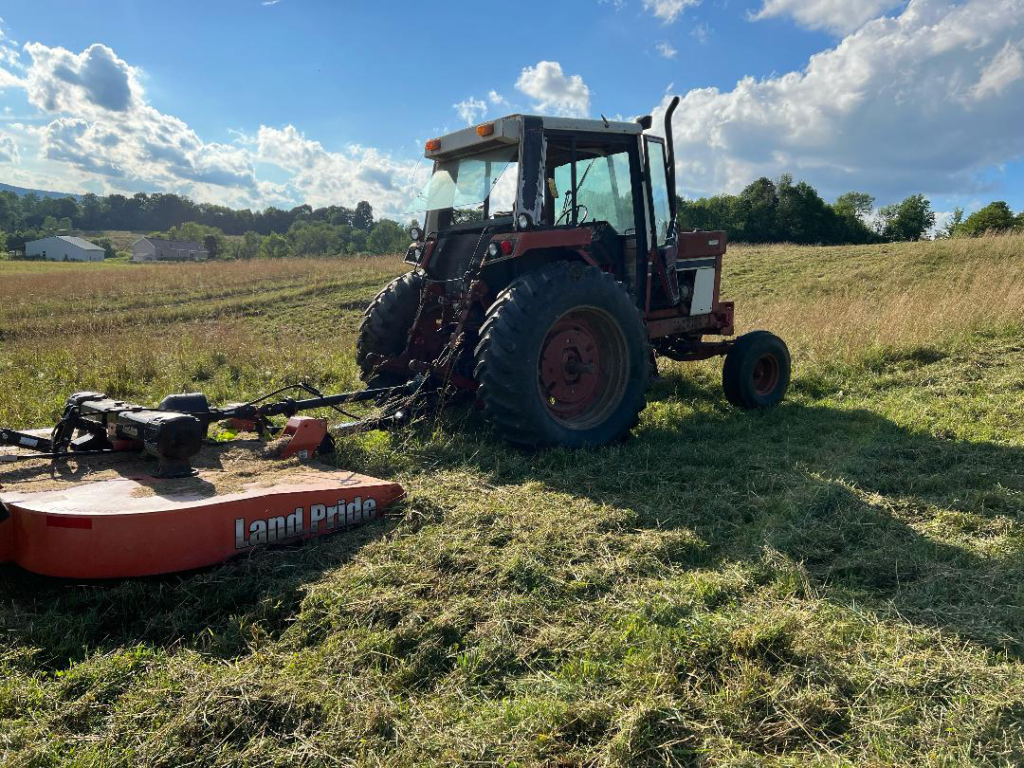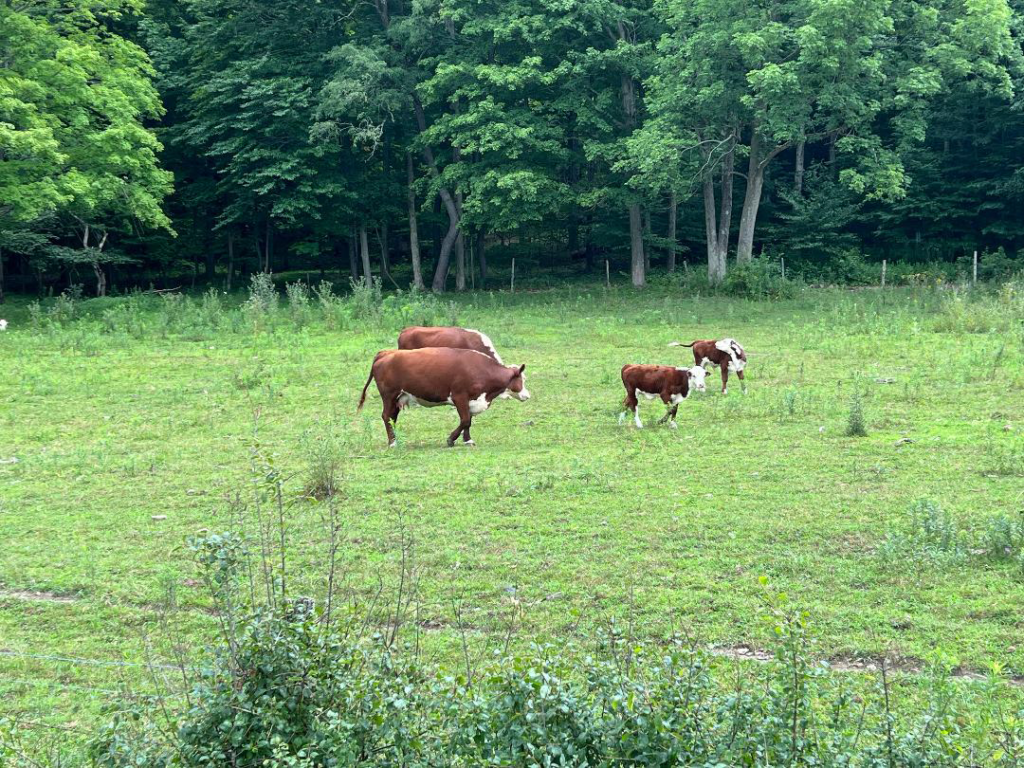Dealing with the Year of the Drought
In part 10 of our “What’s Your Beef?” series on raising cattle on small farms, we share some of our strategies to overcome the obstacles faced in a drought year and what you need to know to keep your cattle producing.
By Rich Taber
As beef producers, we weather all kinds of weather and climatic calamities in our Northeastern climate. Each season brings its own uncertainties to the table. However, I have lived in Central New York for several decades and do not remember a drought year as bad as this one! Yes, we’ve had a few drier than normal summers, but nothing like this year. The summer of 2021 was exactly the opposite! Last summer hayfields lay unmown for much of the summer because of the constant on and off rain that we had, and hay quality suffered for that. However, at least the pastures grew very well! The normal summer slump in grass production that occurs almost every year was minimal. This past year, however, grass growth all but stopped almost completely! The summer of 2022 has been bone dry with far below normal amounts of rain received, and subsequently below par hay and pasture yields. How should we contend with this calamity which many of us don’t have a whole lot of experience dealing with? Sometimes we have had somewhat below normal amounts of rainfall, but it always seems to rain sooner or later, alleviating much of the negatives associated with a drought. Not in 2022 however! By the time that you are all reading this, it will be autumn, and the grazing season will be winding down. There will still be time to react to hay shortages however before the winter sets in. What lessons have we learned this year to prepare us for the future, in this era of ever frequent climate catastrophes?
Whether we are grazing beef cows on pastures, or winter feeding them, the fact remains that we need to provide 3 pounds of forage dry matter (hay equivalent) for every 100 pounds of body weight, for every animal, and for every day. If we don’t accomplish that, then the animals do not receive enough nutrients and will not perform in the desired manner. If we are trying to grass finish animals, then nutritional needs are even more critical.
First, let’s consider hay for the winter. If you make hay for yourself, then I’m sure that your inventories are much less than last year at this time. First cutting seems to have been about normal, as the conditions in late May and June were not too catastrophic at that time. However, second and third cuttings of grasses were way down. Stands with a lot of alfalfa, being a deep-rooted crop, seems to have done ok to an extent, but as mentioned, stands heavy in grasses have done very poorly. Whether you make your own hay, or buy it in, you need to be considering purchasing some before the prices climb to high levels this winter. As I write this in late August, I have seen hay for sale frequently on social media for about the same prices as last year, so don’t wait too long, as the prices have nowhere to go but up in the coming months! You might even consider selling a few animals to lower your feed needs but watch the markets carefully so that you don’t take a bath on their prices! Much of the South, especially Texas, has been liquidating their herds because of an almost total lack of pastures and hay. Market prices will be in disarray all over for quite some time.
For grazing considerations, you may need to be feeding some of that precious winter feed to make up for grazing deficits in the summer and fall. Resting intervals for paddocks will need to be increased drastically as well. It certainly pays to have extra hay in storage, in reserve, to feed as needed when pastures lag behind. Don’t leave animals in their paddocks too long either. Over grazing can cause serious harm to your pastures.

Brushhogging of pastures can be a very good practice, especially during drought years. Rich Taber / CCE Chenango
Sometimes it’s a good practice to brush hog your paddocks after the animals move through them, as the animals don’t like to graze upon brown, dead, parched, weedy paddocks. This year in particular, I have seen much of my grazing paddocks turn into brown, weedy, stalky plant material that the cows don’t seem to want to eat. You can use brush hogs, flail mowers, a diskbine, a sickle bar mower, or an older haybine; whatever works for you to accomplish the purpose. I know that I don’t get too excited about running and depreciating tractors and brushhogs and burning through $5 a gallon diesel fuel, but I feel that the results outweigh the costs. Generally, I try to mow each of my paddocks at least once a year. This year I tried letting cows back into recently mowed paddocks that had a lot of withered forage in them, but they showed little interest in eating any of that forage. Being a drought year, I have seen almost no regrowth in some of my paddocks, necessitating not only inordinately long rest intervals, but little prospect that they can be grazed again this year.
If you have alternative feeds available or can purchase from someone who has extra feed you can feed haylage, corn silage, summer annuals, cover crops, or baleage. Dairy farmers are goods sources of forage and sometimes have leftover feed from the previous year that they might let you buy. You need to be staying on top of your salt and mineral situation during a drought year just as in any other year. Molasses might be a good source of energy to make up for hay and grazing deficiencies.

These animals are grazing in a continuously grazed pasture and are getting few to no nutrients; in a drought year there’s even less for the animals. Rich Taber / CCE Chenango
Another pet peeve that I have is that I see some animals grazing continuously grazed pastures from early in the spring right through the summer and on into the fall and right up until snow flies. Continuous grazing is a poor practice to begin with, and in a drought year is even worse. Such pastures are a poor management strategy in the best of times, and in a drought year there is even less grass for the animals to graze. Remember, those ruminants need to take in about 3% of their body weight daily on a dry matter basis to thrive. If this is what your pastures are like, then the animals need to be supplemented with extra feed.
I drive around the countryside and see many animals grazing week after week in stripped down pastures that have little or no feed value, and with no supplementation. Letting cows and calves into a stripped-down pasture is ok as far as exercise in concerned, but without proper amounts of grass available or supplemental hay available, the animals will not perform as we would like them to. Ruminants, being ruminants, are going to graze whether there’s much grass there or not ; but this is just an illusion that they are taking in enough feed. I have a barnyard winter sacrifice lot that my cows will still graze in some, even with good pastures and hay available to them in feeders. So do not be deceived, just because cows are grazing does not mean that they are taking in anywhere the nutrients that they need! It’s those animals that I see that have no supplemental feed at all grazing right down to the soil but knowing that they are getting little or no nutrients from such a situation. The cow’s milk production will be way down, and the calves will gain little or not at all from a lack of sufficient milk and good grass. This is a situation bordering on animal cruelty.
We can only hope that next year will bring us better weather patterns. Farming is always a gamble, but if we are prepared then we can weather the storm!
This is the tenth installment of articles in our series on raising and managing beef cattle. Previous versions may be seen in the archives of the Small Farm Quarterly.

